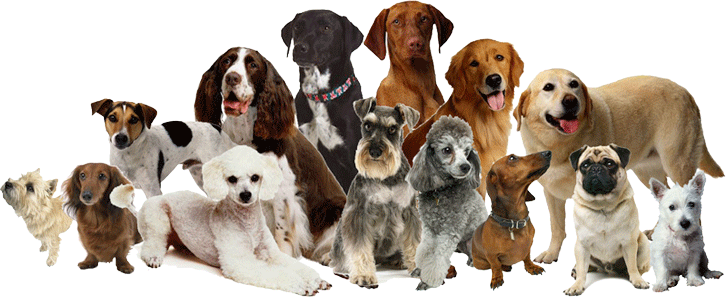How long do dogs live?
It is obvious that humans live longer than dogs. This is a sad fact that every owner of a beloved four-legged friend struggles with when the time comes - it's time to say goodbye. The dog is a beloved and loyal friend and even a family member. He is sometimes a playmate, our defenders, and does not notice our faults. Therefore, we would like him to live with us as long as possible. Thinking about the inevitable loss of a beloved pet often forces owners to ask, 'How long will my dog live?' Of course, there is no way to specifically answer this question. However, thanks to research, age ranges were determined. So, knowing how long our four-legged life can wait, we will provide him with the best care for his age, so that we can spend as much time with him as possible.
It is known that larger animals live longer than smaller ones ... usually. After all, an elephant lives longer than a cat that lives longer than a mouse that lives longer than a fly. But this is not always the case within a given species.
A dog's life span depends on many factors:
- breeds
- size
- genetics
- diets
- lifestyle and care
Breed - and the life span of a dog

Dogs are the most diverse species of mammals in the world. The weight of adult dogs varies greatly. They have very different body build, coat type and color. It also means that there is a great deal of variety in terms of life expectancy. Smaller breeds tend to live longer than larger breed dogs. For example, a Chihuahua lives up to the age of 20 while a Bordeaux Dog has an estimated lifetime of up to 8 years.
Some dog breeds are also simply less prone to various diseases than other breeds.
Purebred dogs have a higher risk of carrying genes for breed-specific diseases. Therefore, mongrels of two or more breeds are less likely to suffer from hereditary health problems and live longer than their purebred counterparts.
Curiosity
The longest-lived dog entered in the Guinness Book of Records was 29 years old. He lived from 1910 to 1939. His name was Bluey, and he was an Australian Cattle Dog.
Later in the article we will present a list of breeds used in the calculator, taking into account the average life expectancy for a particular breed.
Dog size, weight - and life expectancy

Scientists have long wondered why small dog breeds live longer than large dog breeds. This may be because larger dogs develop age-related diseases earlier than smaller breeds. Larger breeds grow at an accelerated rate which can increase the likelihood of abnormal cell growth and death from cancer.
If we want to enjoy the longer life of large and giant breed dogs, we should not influence their growth, e.g. by feeding specially composed food. Because puppies of large and giant breeds should grow slowly, not reaching their full size until they are 2-3 years old.
Small dogs reach skeletal and reproductive maturity faster than larger breeds, and live longer upon reaching maturity. This means that small dogs age faster than large dogs in the first few years of life, but more slowly than large dogs when they reach adulthood. So, oddly enough, the little dog is older than the big dog at two - but younger at five.
Genes - and a dog's lifespan

In addition to size, genetics is undoubtedly linked to longevity. Genes affect the rate of aging and the types of disease animals are susceptible to. As with humans, the life expectancy of an individual dog is probably already determined in the womb. Factors that can influence a dog's lifespan include the mother's diet during pregnancy and the lifespan of an ancestors.
If you are buying a purebred puppy of any size, ask the breeder how long his parents or grandparents usually lived and what they usually died of. The answers will help you find out what to expect with your pet.
Nutrition - and the dog's life expectancy

As with humans, nutrition has a direct impact on the health and longevity of our furry friend.
Keeping your dog lean and fit is an important factor in your dog's life span. As a rule, heavier dogs live shorter lives. Research has shown that underweight dogs live an average of two years longer than overweight dogs.
Another important factor is the food chosen according to the breed, size and age of the dog.
Lifestyle and care - and the dog's life span

Another important factor influencing the longer life of our pets is that we look after them and treat them like real family members. We take care of them, we make sure that they are safe and we regularly care for them. Leash laws help reduce the number of dogs being hit by cars. Our dogs have access to veterinary care very similar to the level of healthcare available to humans. All of these factors play a huge role in extending a dog's life.
If you want your dog to live long, follow these 5 tips:
- Keep him slim and do not feed him more often or more than his race, age and lifestyle require
- Brush his teeth every day or use snacks to cleanse him
- Take him on daily walks, even when he is old, to help maintain muscle strength around arthritic joints
- Train with him regularly and practice new commands
- Take your dog to the vet regularly for a health check
.
How to convert dog age to human age?
As we already know, a dog's life span depends on many factors. But how do you relate dog life expectancy to human life and convert dog years to human? This question is most often asked by owners of growing or older dogs.
Dog's age times seven - are you sure?
For years it was believed that it was enough to multiply the dog's age by seven to convert to human years. Unfortunately, this formula is not exact and it does not work very well nowadays. It probably comes from the 1950s, because at that time it was believed that the average maximum life expectancy of a dog was 10 years, which after conversion was 70 human years. Today, thanks to more knowledge, we know that a dog's life expectancy is more varied and that dogs live longer not only through health care and nutrition.
Curiosity
The longest-lived human with an unambiguously confirmed birth certificate was French Jeanne Calment, who lived to be 122 years and 5 months.
In conclusion - converting a dog's age into human years is more complicated than multiplying his age by seven.
So how do you convert a dog's age into human years?
Unlike humans, dogs grow up faster in their first years of life. They reach full sexual maturity in the first year of life and can be compared to human 16 years old. At the age of two, their development is already 24 human years, but at the age of 3 it is approx. 29 human years.
Smaller breeds of dogs mature faster than larger breeds, but live longer than larger breeds. Therefore, in order to determine the dog's age in relation to human years, it is necessary to correctly assign the dog to the appropriate group.
In order to calculate the age of a dog, they can be divided into several categories depending on their size, and thus weight. The simplest division is:
- Miniature dogs - weight up to 5kg (11lbs)
- Small dogs - weight from 5kg to 12kg (11-25lbs)
- Medium dogs - weight from 12kg to 23kg (25-50lbs)
- Large dogs - weight from 23kg to 45kg (50-99lbs)
- Giant dogs - weight 45 kg (99lbs) upwards
In the dog age calculator to convert into human years depending on the size of the dog, we used the table below.
| DOG AGE |
HUMAN AGE |
| |
Toy
to 5kg (11lbs) |
Small
5-12kg (11-25lbs) |
Medium
12-23kg (25-50lbs) |
Large
23-45kg (50-99lbs) |
Giant
over 45kg (99lbs) |
| show table |
The above division generalizes the calculations depending on the size of the dog. Therefore, the result of converting the dog's age into human years is also generalized. When categorizing a dog, we may also have a problem with matching it properly. Because it is not about the current weight of the dog, but about the knowledge of the weight of an adult individual of a given breed. Without knowing the classification and having a puppy, e.g. West Highland White Terrier, we can incorrectly match it to the group of miniature dogs, or the other way around - medium-sized dogs.
Using the dog's age to human age converter , we can make more precise calculations by choosing the breed of our pet.
The formula used in the calculator to convert a dog's age to a human's age is complicated. It takes into account both the breed of the dog, the weight that can be achieved by an adult individual of a given breed and the expected life span of a dog of this breed.
| Image |
Breed |
Life expectancy |
| hide table |
Of course, there is no calculator, and there is no conversion factor that could be 100% accurate in determining the age of a particular dog in human years. Because there are too many factors influencing his life expectancy.
Vitality is also important because not one adult dog can behave like a puppy. Therefore, no matter how old your dog is in human years, it is most important to look after him until the end of his time and treat him as the best friend and family member.
